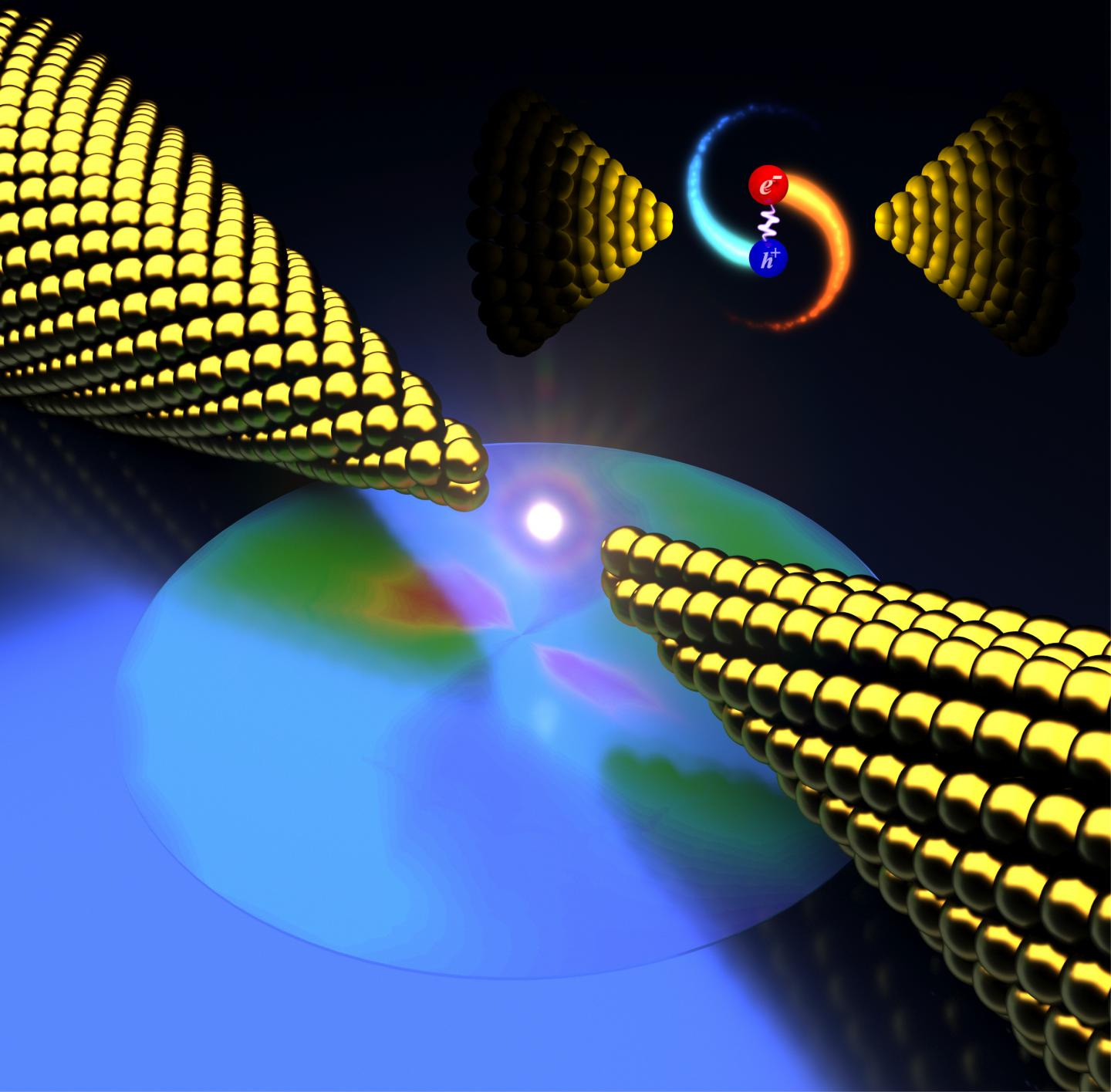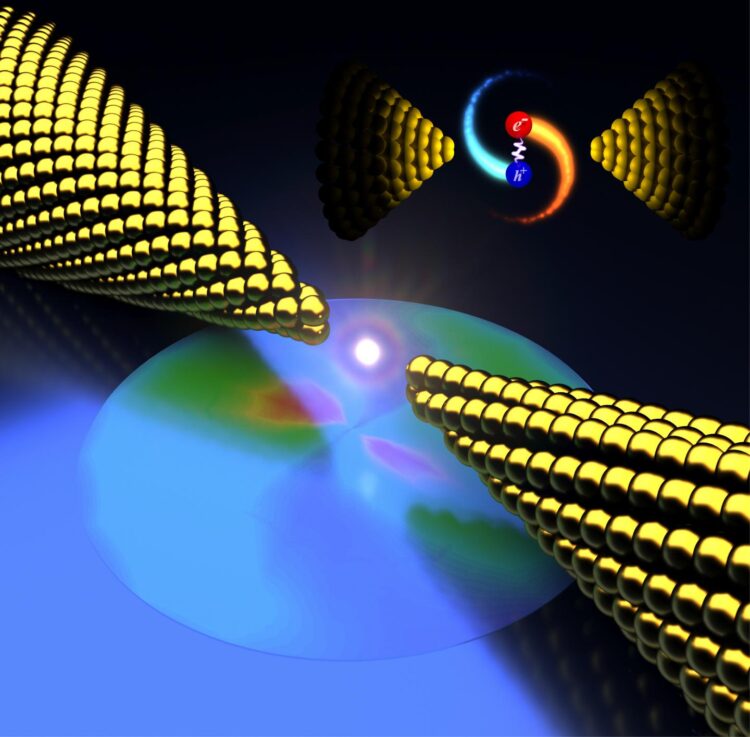Physicists see surprisingly strong light, high heat from nanogaps between plasmonic electrodes

Credit: Illustration by Longji Cui and Yunxuan Zhu/Rice University
HOUSTON – (June 29, 2020) – Seeing light emerge from a nanoscale experiment didn’t come as a big surprise to Rice University physicists. But it got their attention when that light was 10,000 times brighter than they expected.
Condensed matter physicist Doug Natelson and his colleagues at Rice and the University of Colorado Boulder discovered this massive emission from a nanoscale gap between two electrodes made of plasmonic materials, particularly gold.
The lab had found a few years ago that excited electrons leaping the gap, a phenomenon known as tunneling, created a larger voltage than if there were no gap in the metallic platforms.
In the new study in the American Chemical Society journal Nano Letters, when these hot electrons were created by electrons driven to tunnel between gold electrodes, their recombination with holes emitted bright light, and the greater the input voltage, the brighter the light.
The study led by Natelson and lead authors Longji Cui and Yunxuan Zhu appears in the American Chemical Society journal Nano Letters and should be of interest to those who research optoelectronics, quantum optics and photocatalysis.
The effect depends upon the metal’s plasmons, ripples of energy that flow across its surface. “People have explored the idea that the plasmons are important for the electrically driven light emission spectrum, but not generating these hot carriers in the first place,” Natelson said. “Now we know plasmons are playing multiple roles in this process.”
The researchers formed several metals into microscopic, bow tie-shaped electrodes with nanogaps, a test bed developed by the lab that lets them perform simultaneous electron transport and optical spectroscopy. Gold was the best performer among electrodes they tried, including compounds with plasmon-damping chromium and palladium chosen to help define the plasmons’ part in the phenomenon.
“If the plasmons’ only role is to help couple the light out, then the difference between working with gold and something like palladium might be a factor of 20 or 50,” Natelson said. “The fact that it’s a factor of 10,000 tells you that something different is going on.”
The reason appears to be that plasmons decay “almost immediately” into hot electrons and holes, he said. “That continuous churning, using current to kick the material into generating more electrons and holes, gives us this steady-state hot distribution of carriers, and we’ve been able to maintain it for minutes at a time,” Natelson said.
Through the spectrum of the emitted light, the researchers’ measurements revealed those hot carriers are really hot, reaching temperatures above 3,000 degrees Fahrenheit while the electrodes stay relatively cool, even with a modest input of about 1 volt.
Natelson said the discovery could be useful in the advance of optoelectronics and quantum optics, the study of light-matter interactions at vanishingly small scales. “And on the chemistry side, this idea that you can have very hot carriers is exciting,” he said. “It implies that you may get certain chemical processes to run faster than usual.
“There are a lot of researchers interested in plasmonic photocatalysis, where you shine light in, excite plasmons and the hot carriers from those plasmons do interesting chemistry,” he said. “This complements that. In principle, you could electrically excite plasmons and the hot carriers they produce can do interesting chemistry.”
###
Co-authors of the paper are Rice graduate students Mahdiyeh Abbasi and Burak Gerislioglu, lecturer Arash Ahmadivand and Peter Nordlander, the Wiess Chair in Physics and Astronomy and a professor of electrical and computer engineering, and of materials science and nanoengineering. Cui, a former postdoctoral fellow at Rice, is now an assistant professor of mechanical engineering and materials science and engineering at the University of Colorado Boulder. Zhu is a graduate student at Rice. Natelson is chair and a professor of physics and astronomy and a professor of electrical and computer engineering and of materials science and nanoengineering.
The J. Evans Attwell Welch Fellowship, Rice’s Smalley-Curl Institute, the Robert A. Welch Foundation, the University of Colorado, the National Science Foundation and the Air Force Office of Scientific Research supported the research.
Read the abstract at https:/
This news release can be found online at https:/
Follow Rice News and Media Relations via Twitter @RiceUNews.
Related materials:
‘Hot’ electrons don’t mind the gap: http://news.
Single molecules can take the heat: http://news.
Natelson Research Group: http://natelson.
Department of Physics and Astronomy: https:/
Wiess School of Natural Sciences: https:/
Images for download:
https:/
Rice University physicists discover that plasmonic metals can be prompted to produce “hot carriers” that in turn emit unexpectedly bright light in nanoscale gaps between electrodes. The phenomenon could be useful for photocatalysis, quantum optics and optoelectronics. (Credit: Illustration by Longji Cui and Yunxuan Zhu/Rice University)
https:/
At top, an illustration shows the experimental setup developed at Rice University to study the effect of how current prompts localized surface plasmons (LSPs) to produce hot carriers in the nanogap between two electrodes. Center, a photo shows a light-emitting tunnel junction between two gold electrodes with input from 1 to 1.2 volts. At bottom, a spectrographic plot shows the photon energy and intensity produced at the junction. (Credit: Natelson Research Group/Rice University)
Located on a 300-acre forested campus in Houston, Rice University is consistently ranked among the nation’s top 20 universities by U.S. News & World Report. Rice has highly respected schools of Architecture, Business, Continuing Studies, Engineering, Humanities, Music, Natural Sciences and Social Sciences and is home to the Baker Institute for Public Policy. With 3,962 undergraduates and 3,027 graduate students, Rice’s undergraduate student-to-faculty ratio is just under 6-to-1. Its residential college system builds close-knit communities and lifelong friendships, just one reason why Rice is ranked No. 1 for lots of race/class interaction and No. 4 for quality of life by the Princeton Review. Rice is also rated as a best value among private universities by Kiplinger’s Personal Finance.
Media Contact
Jeff Falk
[email protected]
713-348-6775
Original Source
https:/
Related Journal Article
http://dx.





